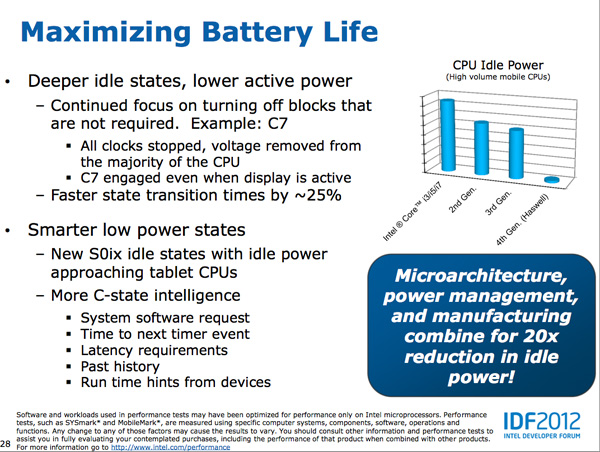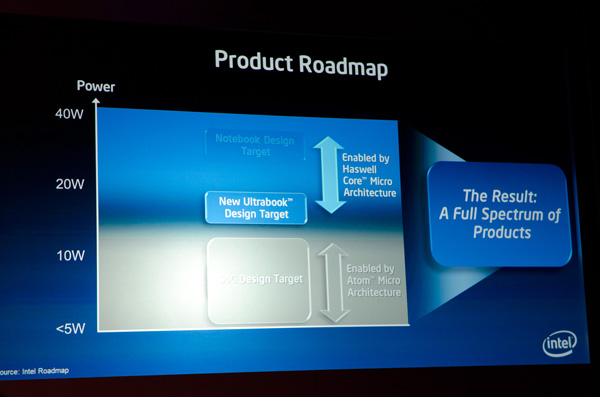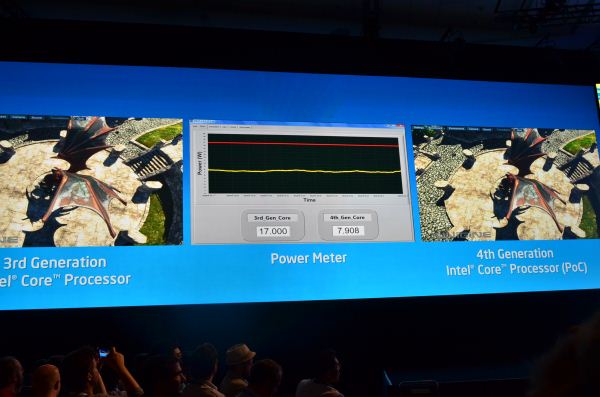Intel's Haswell Architecture Analyzed: Building a New PC and a New Intel
by Anand Lal Shimpi on October 5, 2012 2:45 AM ESTOther Power Savings
Haswell's power savings come from three sources, all of which are equally important. We already went over the most unique: Intel's focus on reducing total platform power consumption by paying attention to everything else on the motherboard (third party controllers, voltage regulation, etc...). The other two sources of power savings are more traditional, but still very significant.

At the micro-architecture level Intel added more power gating and low power modes to Haswell. The additional power gating gives the power control unit (PCU) more fine grained control over shutting off parts of the core that aren't used. Intel published a relatively meaningless graph showing idle power for standard voltage mobile Haswell compared to the previous three generations of Core processors.
Haswell can also transition between power states approximately 25% faster than Ivy Bridge, which lets the PCU be a bit more aggressive in which power state it selects since the penalty of coming out of it is appreciably lower. It's important to put the timing of all of this in perspective. Putting the CPU cores to sleep and removing voltage/power from them even for a matter of milliseconds adds up to the sort of savings necessary to really enable the sort of always-on, always-connected behavior Haswell based systems are expected to deliver.
Intel has also done a lot of work at the process level to bring Haswell's power consumption down. As a tock, Haswell is the second micro-architecture to use Intel's new 22nm tri-gate transistors. The learnings from Ivy Bridge are thus all poured into Haswell. Intel wasn't too specific on what it did on the manufacturing side to help drive power down in Haswell other than to say that a non-insignificant amount of work came from the fabs.
The Fourth Haswell
At Computex Intel's Mooly Eden showed off this slide that positioned Haswell as a 15-20W part, while Atom based SoCs would scale up to 10W and perhaps beyond:
Just before this year's IDF Intel claimed that Haswell ULT would start at 10W, down from 17W in Sandy/Ivy Bridge. Finally, at IDF Intel showed a demo of Haswell running the Unigen Heaven benchmark at under 8W:
The chain of events tells us two things: 1) Intel likes to play its cards close to its chest, and 2) the sub-10W space won't be serviced by Atom exclusively.
Intel said Haswell can scale below 10W, but it didn't provide a lower bound. It's too much to assume Haswell would go into a phone, but once you get to the 8W point and look south you open yourself up to fitting into things the size of a third generation iPad. Move to 14nm, 10nm and beyond then it becomes more feasible that you could fit this class of architecture into something even more portable.
Intel is being very tight lipped about the fourth client Haswell (remember the first three were desktop, mobile and ultra-low-volt/Ultrabook) but it's clear that it has real aspirations to use it in a space traditionally reserved for ARM or Atom SoCs.
One of the first things I ever heard about Haswell was that it was Intel's solution to the ARM problem. I don't believe a 10W notebook is going to do anything to the ARM problem, but a sub-8W Haswell in an iPad 3 form factor could be very compelling. Haswell won't be fanless, but Broadwell (14nm) could be. And that could be a real solution to the ARM problem, at least outside of a phone.
As I said before, I don't see Haswell making it into a phone but that's not to say a future derivative on a lower power process wouldn't.













245 Comments
View All Comments
Kepe - Friday, October 5, 2012 - link
Let's see. I think we can agree that the Samsung Galaxy S III was the most important Android phone launch of the summer, so it should get comparable treatment if Anandtech was completely neutral. Let's compare the articles about the SGS III vs. iPhone 5Doing a search on anandtech.com gives us 8 articles/news posts about the SGS III vs. 13 articles/news posts about the iPhone 5.
SGS 3:
Five news stories about product announcements
Performance Preview article
Preview article
Review article
iPhone 5:
Why iPhone 5 isn't launched in 2011 article
Analyzing rumours about iPhone 5 article
New SoC in iPhone 5 article
iPhone 5 Live Blog from the product launch seremony
Three news stories about new features and product announcements
iPhone 5 Hands On article
Lack of simultaneous voice and LTE/EVDO article
Analyzing Geekbench results article
Sunspider Performance Analysis article
Performance Preview article
iPhone 5 Display Thoroughly Analyzed article
+ The upcoming iPhone 5 Review article
+ articles such as "iOS6 Maps Thoroughly Investigated"
Look at the difference. It's quite clear which device gets more coverage. And it's the same thing for older iPhones. Articles such as "Camping out for the new iPhone 3GS".
This is NOT equal treatment of all products. This is why my trust for Anandtech has started to slip. Yes, Anandtech still is the best place for reviews, but one really has to wonder if those reviews still are as neutral and objective as they used to be.
vFunct - Saturday, October 6, 2012 - link
It's an android device. Android devices do not matter. Everyone uses iPhones anyways, They are better. Apple makes better products, including laptops.No need to waste space on Android.
Haugenshero - Saturday, October 6, 2012 - link
Please take your pointless apple fanboy drivel to another site that doesn't care about actual hardware and software and just like shiny things.cjl - Saturday, October 6, 2012 - link
Apple's (iOS) current sales are only 20% of the overall smartphone market share, while Android is over 60%, so if either one of the two is largely irrelevant, it's apple.HisDivineOrder - Sunday, October 7, 2012 - link
Shhhh, icks-nay on the facts-nay.You might cause a fanboy's head to explode near one of those inconveniently placed explosive barrels we walk by in real life.
Just imagine a chain reaction. Caused by an Apple fan's mind being blown. You might take out an entire city block.
Do you want that kind of devastation on your karma? Think different. ;)
vFunct - Sunday, October 7, 2012 - link
The Android market is the cheap giveaways.No one willingly pays money for an Android phone.
Not everyone can afford the premium quality of an Apple product. They will have to settle for an inferior Android devices instead until they can afford higher quality products.
Kepe - Monday, October 8, 2012 - link
Nice trolling there. Now go back under the bridge and stay there =)Old_Fogie_Late_Bloomer - Tuesday, October 9, 2012 - link
"Not everyone can afford the premium quality of an Apple product. They will have to settle for an inferior Android devices instead until they can afford higher quality products."Ha ha ha! Well done, if you're screwing around.
But seriously, if you actually believe that, seek psychiatric help. :-P
Spunjji - Thursday, October 18, 2012 - link
Hahahahahahahahahahahahahahahahahahahahahasolipsism - Tuesday, October 9, 2012 - link
And how many of the 20% is on one phone? Let me know when you figure out how to cover every single Androd-based device that hits the market in a given year.